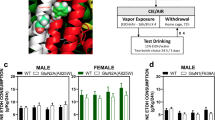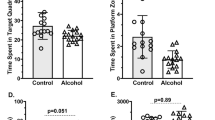Abstract
Ethanol (EtOH) intake leads to modulation of glutamatergic transmission, which may contribute to ethanol intoxication, tolerance and dependence. To study metabolic responses to the hyper glutamatergic status at synapses during ethanol exposure, we used Glud1 transgenic (tg) mice that over-express the enzyme glutamate dehydrogenase in brain neurons and release excess glutamate (Glu) in synapses. We measured neurochemical changes in the hippocampus and striatum of tg and wild-type (wt) mice using proton magnetic resonance spectroscopy before and after the animals were fed with diets within which EtOH constituting up to 6.4% of total calories for 24 weeks. In the hippocampus, the EtOH diet led to significant increases in concentrations of EtOH, glutamine (Gln), Glu, phosphocholine (PCho), taurine, and Gln + Glu, when compared with their baseline concentrations. In the striatum, the EtOH diet led to significant increases in concentrations of GABA, Gln, Gln + Glu, and PCho. In general, neurochemical changes were more pronounced in the striatum than the hippocampus in both tg and wt mice. Overall neurochemical changes due to EtOH exposure were very similar in tg and wt mice. This study describes time courses of neurochemical profiles before and during chronic EtOH exposure, which can serve as a reference for future studies investigating ethanol-induced neurochemical changes.








Similar content being viewed by others
References
Krystal JH, Petrakis IL, Mason G, Trevisan L, D’Souza DC (2003) N-methyl-d-aspartate glutamate receptors and alcoholism: reward, dependence, treatment, and vulnerability. Pharmacol Ther 99:79–94
Tabakoff B, Hoffman PL (1995) Pharmacological effects of ethanol on the nervous system. CRC Press, New York
Tsai G, Gastfriend DR, Coyle JT (1995) The glutamatergic basis of human alcoholism. Am J Psychiatry 152:332–340
Allan AM, Harris RA (1987) Acute and chronic ethanol treatments alter GABA receptor-operated chloride channels. Pharmacol Biochem Behav 27:665–670
Lovinger DM, White G, Weight FF (1989) Ethanol inhibits NMDA-activated ion current in hippocampal neurons. Science 243:1721–1724
Hoffman PL, Rabe CS, Moses F, Tabakoff B (1989) N-methyl-d-aspartate receptors and ethanol: inhibition of calcium flux and cyclic GMP production. J Neurochem 52:1937–1940
Lima-Landman MT, Albuquerque EX (1989) Ethanol potentiates and blocks NMDA-activated single-channel currents in rat hippocampal pyramidal cells. FEBS Lett 247:61–67
White G, Lovinger DM, Weight FF (1990) Ethanol inhibits NMDA-activated current but does not alter GABA-activated current in an isolated adult mammalian neuron. Brain Res 507:332–336
Kotlinska J, Liljequist S (1997) The NMDA/glycine receptor antagonist, L-701,324, produces discriminative stimuli similar to those of ethanol. Eur J Pharmacol 332:1–8
Foley TD, Rhoads DE (1992) Effects of ethanol on Na(+)-dependent amino acid uptake: dependence on rat age and Na+, K(+)-ATPase activity. Brain Res 593:39–44
Hitzemann R, Mark C, Panini A (1982) Effects of free fatty acids, ethanol and development on gamma-aminobutyric acid and glutamate fluxes in rat nerve endings. Biochem Pharmacol 31:4039–4044
Smith TL, Zsigo A (1996) Increased Na(+)-dependent high affinity uptake of glutamate in astrocytes chronically exposed to ethanol. Neurosci Lett 218:142–144
Svensson L, Wu C, Johannessen K, Engel JA (1992) Effect of ethanol on ascorbate release in the nucleus accumbens and striatum of freely moving rats. Alcohol 9:535–540
Shimizu K, Matsubara K, Uezono T, Kimura K, Shiono H (1998) Reduced dorsal hippocampal glutamate release significantly correlates with the spatial memory deficits produced by benzodiazepines and ethanol. Neuroscience 83:701–706
Tiwari V, Veeraiah P, Subramaniam V, Patel AB (2014) Differential effects of ethanol on regional glutamatergic and GABAergic neurotransmitter pathways in mouse brain. J Neurochem 128:628–640
Chefer V, Meis J, Wang G, Kuzmin A, Bakalkin G, Shippenberg T (2011) Repeated exposure to moderate doses of ethanol augments hippocampal glutamate neurotransmission by increasing release. Addict Biol 16:229–237
Zahr NM, Rohlfing T, Mayer D, Luong R, Sullivan EV, Pfefferbaum A (2016) Transient CNS responses to repeated binge ethanol treatment. Addict Biol 21:1199–1216
Rao PSS, Bell RL, Engleman EA, Sari Y (2015) Targeting glutamate uptake to treat alcohol use disorders. Front Neurosci 9:144
Keller E, Cummins JT, von Hungen K (1983) Regional effects of ethanol on glutamate levels, uptake and release in slice and synaptosome preparations from rat brain. Subst Alcohol Actions Misuse 4:383–392
Ruden DM, Michaelis ML, Benremouga A, Michaelis EK (1999) Enhanced sensitivity to ethanol in Drosophila with mutations in glutamate biosynthetic enzymes. Alcoholism 23:61
Morozova TV, Anholt RR, Mackay TF (2007) Phenotypic and transcriptional response to selection for alcohol sensitivity in Drosophila melanogaster. Genome Biol 8:R231
Bao X, Pal R, Hascup KN, Wang Y, Wang WT, Xu W, Hui D, Agbas A, Wang X, Michaelis ML, Choi IY, Belousov AB, Gerhardt GA, Michaelis EK (2009) Transgenic expression of Glud1 (glutamate dehydrogenase 1) in neurons: in vivo model of enhanced glutamate release, altered synaptic plasticity, and selective neuronal vulnerability. J Neurosci 29:13929–13944
Michaelis EK, Wang X, Pal R, Bao X, Hascup KN, Wang Y, Wang WT, Hui D, Agbas A, Choi IY, Belousov A, Gerhardt GA (2011) Neuronal Glud1 (glutamate dehydrogenase 1) over-expressing mice: increased glutamate formation and synaptic release, loss of synaptic activity, and adaptive changes in genomic expression. Neurochem Int 59:473–481
Cooper AJL (2012) The role of glutamine synthetase and glutamate dehydrogenase in cerebral ammonia homeostasis. Neurochem Res 37:2439–2455
Palaiologos G, Hertz L, Schousboe A (1988) Evidence that aspartate aminotransferase activity and ketodicarboxylate carrier function are essential for biosynthesis of transmitter glutamate. J Neurochem 51:317–320
Palaiologos G, Hertz L, Schousboe A (1989) Role of aspartate aminotransferase and mitochondrial dicarboxylate transport for release of endogenously and exogenously supplied neurotransmitter in glutamatergic neurons. Neurochem Res 14:359–366
Christensen T, Bruhn T, Diemer NH, Schousboe A (1991) Effect of phenylsuccinate on potassium- and ischemia-induced release of glutamate in rat hippocampus monitored by microdialysis. Neurosci Lett 134:71–74
Calabrese V, Scapagnini G, Latteri S, Colombrita C, Ravagna A, Catalano C, Pennisi G, Calvani M, Butterfield DA (2002) Long-term ethanol administration enhances age-dependent modulation of redox state in different brain regions in the rat: protection by acetyl carnitine. Int J Tissue React 24:97–104
DeCarli LM, Lieber CS (1967) Fatty liver in the rat after prolonged intake of ethanol with a nutritionally adequate new liquid diet. J Nutr 91:331–336
Gruetter R (1993) Automatic, localized invivo adjustment of all 1st-order and 2nd-order shim coils. Magn Reson Med 29:804–811
Mlynarik V, Gambarota G, Frenkel H, Gruetter R (2006) Localized short-echo-time proton MR spectroscopy with full signal-intensity acquisition. Magn Reson Med 56:965–970
Chen G, Cuzon Carlson VC, Wang J, Beck A, Heinz A, Ron D, Lovinger DM, Buck KJ (2011) Striatal involvement in human alcoholism and alcohol consumption, and withdrawal in animal models. Alcohol Clin Exp Res 35:1739–1748
Dyr W, Siemiatkowski M, Krzascik P, Bidzinski A, Plaznik A, Kostowski W (2002) Neurotransmitter levels and [3H]muscimol binding sites in the brain of rats selectively bred for alcohol preference and non-preference. Pol J Pharmacol 54:225–230
Canales JJ (2013) Deficient plasticity in the hippocampus and the spiral of addiction: focus on adult neurogenesis. Curr Top Behav Neurosci 15:293–312
Koob GF, Volkow ND (2010) Neurocircuitry of addiction. Neuropsychopharmacology 35:217–238
Provencher SW (1993) Estimation of metabolite concentrations from localized in-vivo proton Nmr-spectra. Magn Reson Med 30:672–679
Meyer SL (1975) Data analysis for scientists and engineers. Wiley, New York
R Development Core Team (2010) R: A language and environment for statistical computing. R Foundation for Statistical Computing, Vienna
Carrera I, Kircher PR, Meier D, Richter H, Beckman K, Dennler M (2014) In vivo proton magnetic resonance spectroscopy for the evaluation of hepatic encephalopathy in dogs. Am J Vet Res 75:818–827
Gupta RK, Dhiman RK (2003) Magnetic resonance imaging and spectroscopy in hepatic encephalopathy. Indian J Gastroenterol 22:S45–S49
Hassan EA, Abd El-Rehim AS, Seifeldein GS, Shehata GA (2014) Minimal hepatic encephalopathy in patients with liver cirrhosis: magnetic resonance spectroscopic brain findings versus neuropsychological changes. Arab J Gastroenterol 15:108–113
Li Y, Mei L, Qiang J, Ju S, Zhao S (2016) Magnetic resonance spectroscopy for evaluating portal-systemic encephalopathy in patients with chronic hepatic Schistosomiasis japonicum. PLoS Negl Trop Dis 10:e0005232
Ross BD, Danielsen ER, Bluml S (1996) Proton magnetic resonance spectroscopy: the new gold standard for diagnosis of clinical and subclinical hepatic encephalopathy? Dig Dis 1:30–39
Duarte JM, Do KQ, Gruetter R (2014) Longitudinal neurochemical modifications in the aging mouse brain measured in vivo by 1H magnetic resonance spectroscopy. Neurobiol Aging 35:1660–1668
Lee MR, Hinton DJ, Wu J, Mishra PK, Port JD, Macura SI, Choi DS (2011) Acamprosate reduces ethanol drinking behaviors and alters the metabolite profile in mice lacking ENT1. Neurosci Lett 490:90–95
Liu H, Zheng W, Yan G, Liu B, Kong L, Ding Y, Shen Z, Tan H, Zhang G (2014) Acute ethanol-induced changes in edema and metabolite concentrations in rat brain. Biomed Res Int 351903:25
Zahr NM, Mayer D, Rohlfing T, Hasak MP, Hsu O, Vinco S, Orduna J, Luong R, Sullivan EV, Pfefferbaum A (2010) Brain injury and recovery following binge ethanol: evidence from in vivo magnetic resonance spectroscopy. Biol Psychiatry 67:846–854
Zahr NM, Mayer D, Vinco S, Orduna J, Luong R, Sullivan EV, Pfefferbaum A (2009) In vivo evidence for alcohol-induced neurochemical changes in rat brain without protracted withdrawal, pronounced thiamine deficiency, or severe liver damage. Neuropsychopharmacology 34:1427–1442
Peel AL, Zolotukhin S, Schrimsher GW, Muzyczka N, Reier PJ (1997) Efficient transduction of green fluorescent protein in spinal cord neurons using adeno-associated virus vectors containing cell type-specific promoters. Gene Ther 4:16–24
Wallimann T, Wyss M, Brdiczka D, Nicolay K, Eppenberger HM (1992) Intracellular compartmentation, structure and function of creatine kinase isoenzymes in tissues with high and fluctuating energy demands: the ‘phosphocreatine circuit’ for cellular energy homeostasis. Biochem J 281(Pt 1):21–40
Braissant O, Henry H, Villard AM, Zurich MG, Loup M, Eilers B, Parlascino G, Matter E, Boulat O, Honegger P, Bachmann C (2002) Ammonium-induced impairment of axonal growth is prevented through glial creatine. J Neurosci 22:9810–9820
Van Pilsum JF, Stephens GC, Taylor D (1972) Distribution of creatine, guanidinoacetate and the enzymes for their biosynthesis in the animal kingdom. Implications for phylogeny. Biochem J 126:325–345
Denays R, Chao SL, Mathur-Devre R, Jeghers O, Fruhling J, Noel P, Ham HR (1993) Metabolic changes in the rat brain after acute and chronic ethanol intoxication: a 31P NMR spectroscopy study. Magn Reson Med 29:719–723
Choi IY, Lee P, Wang WT, Hui D, Wang X, Brooks WM, Michaelis EK (2014) Metabolism changes during aging in the hippocampus and striatum of glud1 (glutamate dehydrogenase 1) transgenic mice. Neurochem Res 39:446–455
Wood WG, Armbrecht HJ, Wise RW (1982) Ethanol intoxication and withdrawal among three age groups of C57BL/6NNIA mice. Pharmacol Biochem Behav 17:1037–1041
Allen DL, Little RG 2nd, Theotokatos JE, Petersen DR (1982) Ethanol elimination rates in mice: effects of gender, nutrition, and chronic ethanol treatment. Pharmacol Biochem Behav 16:757–760
Fein G, Meyerhoff DJ (2000) Ethanol in human brain by magnetic resonance spectroscopy: correlation with blood and breath levels, relaxation, and magnetization transfer. Alcohol Clin Exp Res 24:1227–1235
Gilpin NW, Smith AD, Cole M, Weiss F, Koob GF, Richardson HN (2009) Operant behavior and alcohol levels in blood and brain of alcohol-dependent rats. Alcohol Clin Exp Res 33:2113–2123
LeBlanc AE, Kalant H, Gibbins RJ (1975) Acute tolerance to ethanol in the rat. Psychopharmacologia 41:43–46
Larsen M, Langmoen IA (1998) The effect of volatile anaesthetics on synaptic release and uptake of glutamate. Toxicol Lett 101:59–64
Zhu C, Gao J, Karlsson N, Li Q, Zhang Y, Huang Z, Li H, Kuhn HG, Blomgren K (2010) Isoflurane anesthesia induced persistent, progressive memory impairment, caused a loss of neural stem cells, and reduced neurogenesis in young, but not adult, rodents. J Cereb Blood Flow Metab 30:1017–1030
Kulak A, Duarte JM, Do KQ, Gruetter R (2010) Neurochemical profile of the developing mouse cortex determined by in vivo 1H NMR spectroscopy at 14.1 T and the effect of recurrent anaesthesia. J Neurochem 115:1466–1477
Funding
This study was funded by National Institute on Aging (AG 12993, AG 035982), Kansas City Area Life Sciences Institute (KCALSI-07-13).
Author information
Authors and Affiliations
Corresponding author
Additional information
Special issue: In honor of Elias K. Michaelis.
Rights and permissions
About this article
Cite this article
Wang, WT., Lee, P., Hui, D. et al. Effects of Ethanol Exposure on the Neurochemical Profile of a Transgenic Mouse Model with Enhanced Glutamate Release Using In Vivo 1H MRS. Neurochem Res 44, 133–146 (2019). https://doi.org/10.1007/s11064-018-2658-9
Received:
Revised:
Accepted:
Published:
Issue Date:
DOI: https://doi.org/10.1007/s11064-018-2658-9




